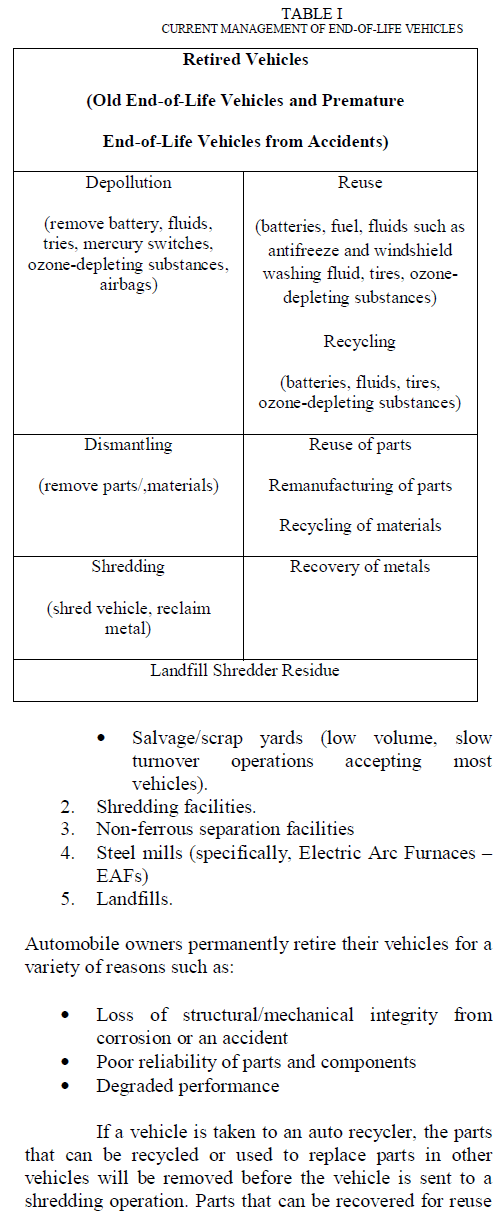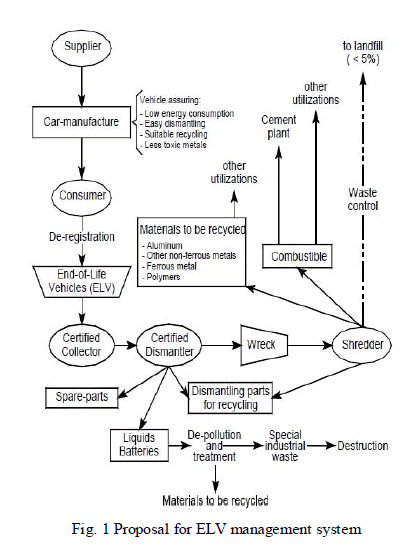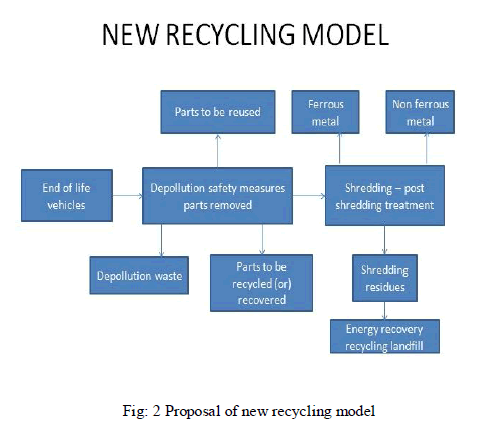ISSN ONLINE(2319-8753)PRINT(2347-6710)
ISSN ONLINE(2319-8753)PRINT(2347-6710)
Dr.G.D.Sivakumar1, S.Godw in barnabas2 and S.Anatharam2
|
| Related article at Pubmed, Scholar Google |
Visit for more related articles at International Journal of Innovative Research in Science, Engineering and Technology
The objective of this work is to penetrate very briefly for the previous works that has been done on the material recycling in automobiles. By doing so the various ideas that have been generated worldwide and their case study related to this task will came to know. The brief search on this work gives information about the methodologies /tools they used in their work. All these steps will provide the gap in the literature review to find out the new model for recycling, improving performance of shredding facilities and new modes of recycling etc.,
Keywords |
| End of life cycle, Automobile Shredder Residue, Recycling Process, MaterialManagement. |
INTRODUCTION |
| Cars are one of the most recycled commercial products. Currently, approximately 75% of the total vehicle weight is recycled. The End-of-life vehicles try to push the recycling process further: it fixed the percentage of recyclability (85%) and recoverability (95%). The motivation for this work comes first from the observation of the material consumption of the automotive industry. The automobile is a major material consumer. Nowadays 95% of all vehicles go through the recycling process at their end of life. This collection rate is very high. By comparison, it is only of 52%, 55% and 42% for appliances, the efficiency of the recycling industry leads to a 75 % weight of vehicle recycled. Finally, the remaining 25%, known as Auto Shredder Residue (ASR), go to landfill. ASR is mainly Composed of foams and fluff (40-52%), plastics (20-27%), rubbers (18-22%) and metals (4-15%) and there is currently no cost-effective recycling technology for plastics and foam. |
| The elements of the recycling chain which deal directly with ELVs can be divided into three major steps: pretreatment, dismantling, and shredding. Emerging from first to the store yard of a dismantler, which can either be open and exposed to the elements or covered. The dismantler first removes all hazardous parts and fluids. This step is called pretreatment. The fluids typically removed include engine oil, coolant, refrigerant, steering oil, washer fluid, antifreeze, transmission oil, brake fluid, fuel, coolant and any remaining fuel. These fluids can either be removed by gravity or using pumps. At this stage, the dismantler typically also removes the tires, batteries, airbags and all parts presenting a potential hazard. After that, the hulk is typically crushed. It is then easy to handle and to transport to the next step: the shredder. The shredder takes the compacted car through hammer mills. These hammer mills shred the vehicle. |
END OF LIFE VECHICLE MANAGEMENT |
| The ELV management system lacks regulations and its controls however, governments are developing guidelines for automotive recyclers to follow. |
| Governments tend to approach the ELV management systems using an EPR (Extended Producer Responsibility) approach. EPR makes the original manufacturer responsible for the end-of-life management costs by doing this it promotes manufacturers to increase the recyclability, reduce the wastes and toxicity, and allow for easier reuse and remanufacturing of their products. While some governments opt for full EPR, others tend to lean towards shared responsibility between the manufacturers and government. |
| The ELV management activities are: |
| 1. Dismantlers, consisting of two distinct types: |
| • High-value parts dismantlers (high volume, quick turnover operations targeting latemodel vehicles). |
 |
| or remanufacturing include AC compressors, water pumps, carburetors, calipers, power steering pumps, carrier assembly, alternator, starters, transmissions, axle assemblies, engines, and transfer cases. Batteries, catalytic converters, radiators and tires are also removed from end-of-life vehicles for recycling. The following chart shows the way in which ELVs are generally managed: These words are getting popular day by day. However, their explicit meaning is described below: |
| Reuse - Components used for the same purpose for which they were conceived (Staudinger and Keoleian, 2001). |
| Remanufacturing - Remanufacturing or “to as good as new condition” is a three-step process, where |
| (i) A used product is disassembled |
| (ii) Its parts are cleaned and repaired |
| (iii) The parts are reassembled to a sound working condition (Scott, 2012). |
| Recycling- It is the reprocessing of waste materials for original purpose or other (excluding energy recovery) (Staudinger and Keoleian, 2001). |
REVIEW OF THE CURRENT SITUATION OF THE INDIAN SCRAP MARKET |
| In India, cars are driven for 15-20 years until they can no longer be cajoled into life often land at scrap dealers, to be dismantled and their innards reused with little regard for the environment. With rapidly increasing population of new cars there is a concurrent need for modern facilities for recycling and recovering materials from old cars and used cars, which reach their End-of-life (EOL). A recycling unit was launched on 2nd August 2011, 55km outside Chennai, close to the local factories of foreign auto makers including Ford Motor Co. and the Renault-Nissan alliance, may offer a cleaner and greener solution for the reuse or disposal of automotive parts. The 340-acre facility to the south-west of Chennai, in Oragadam, is a creation of SIAM, NATRIP and the ministry of heavy industries (Global Automotive Research Centre) that will dismantle cars that are no longer road-worthy (NATRIP, 2011). |
| With the rapidly increasing volume of vehicles in India, there is a parallel need for modern facilities for its reuse and recovery when the vehicle reaches its EOL (End-of-Life). The junkyards in India are full of old vehicles which have no more usability and its number is continuously increasing. If we compare with the European countries and some Asian countries like Japan, there are no regulations in India to deal with the disposal of old vehicles which have no more utility. |
PROPOSAL FOR ELV MANAGEMENT SYSTEM |
 |
| At present, modern recycling facilities are able to recover over 95% of the ferrous and nonferrous metals in ELVs. The less than 5% of the residual metals that remain in the shredder residue constitute about 5–15% of the weight of the shredder residue. To facilitate the recycling of non-metallic materials from shredder residue, the dismantling industry, repair shops, the shredding industry, and automobile manufacturers must work together. |
| The shredding industry can: |
| 1. Provide expertise in the shredding and separation of shredder residue components. |
| 2. Become more selective in choosing their feedstock’s and planning their shredding campaigns to prevent cross contamination of the residues and to reduce the number of species in the shredder residue that must be separated. |
| 3. Develop markets for the recycled materials. |
| The dismantling industry can: |
| 1. Increase the number and amount of materials and parts that can be removed by dismantling. |
| 2. Endeavor to market and use the dismantled materials, because the dismantled parts are not as contaminated as the shredded materials. |
| 3. Sort, save, and ship defective and damaged parts for recycling. Some repair shops segregate TPO bumpers and sell them for recycling. |
| 4. Recover automotive fluids from defective and damaged parts and send them for recycling. |
| Car manufacturers can: |
| 1. Design cars for easy dismantling of potentially reusable parts, so the dismantlers can recover additional parts for reuse and recycling more efficiently and economically. |
| 2. Reduce the number of polymer species used in building vehicles. |
| 3. Eliminate or minimize the use of hazardous materials and substances of concern (SOC) that could make recycling more difficult or expensive. |
RECYCLING BARRIERS AND RECYCLING STRATEGIES |
| 1. Unavailability of adequate collection systems for certain waste materials. In the case of ELVs, the collection infrastructure is already in place. |
| 2. Lack of technology to identify, separate, and recover quality recyclables economically from the waste stream. Separation and cleaning of the desired materials at a high enough purity for recycling can be complicated and costly, depending on the characteristics and composition of the waste stream. A clear example is the separation and cleaning of plastics from shredder residue. |
| 3. Incompatibility of different materials. For example, most polymers are not compatible with each other, and the separation from each other can be challenging and costly. Compatibilizer research by the VRP and others indicates that compatibilizers (e.g., block-co-polymers) may compatibilize some mixtures of commingled plastics without the presence of PVC (e.g., municipal solid waste). |
| 4. Market value of the recovered materials (i.e., available amounts, market price of the recovered material, etc.). The price of recycled plastics and foam has been fluctuating and in many cases is dependent on export of the materials overseas. |
PROPOSAL OF NEW RECYCLING MODEL |
| The above new recycling model is one of the effective recycling techniques for the automobile material recycling which reduces the scarab rate in the shredder residue. |
 |
| Recycling strategies can be divided into four major types: (1) recovery of materials for recycling into primary products, (2) recovery of materials for recycling into secondary or lower grade products, (3) chemical and thermo chemical recycling into chemicals and fuels, and (4) recovery of the energy value. |
LIMITATIONS OF THE INDIAN SCENARIO |
| a. One limitation that has been found in the study is the inadequate description of material flows and economic transactions. For example, in India the vehicle dismantlers are mainly concerned about selling quality parts and components. Material composition of the parts and components does not affect the profitability as long as the customer is satisfied with the used part and component. |
| b. Second limitation is the lack of consideration for the government interactions in the sustainability of vehicles. In India there are no such regulations and directives like in Europe regarding End-of-Life Management of Vehicles (ELMVs) which can cause designers to think about the effective automotive recovery at the design stage. |
| c. Third limitation is the recycling of plastics and composite materials whose percentage is growing with the technology enhancement and it is causing a negative impact on the environmental and economic sustainability of automotive recovery infrastructure. |
CONCLUSION |
| This paper presents an effective approach to improve recycling methods and creating new model for recycling. The modeling of the optimal ELVs treatment chain, in terms of best practices and best available techniques for both the improvement of the ELVs recycling rate and the production of cleaner streams of secondary raw materials. The logical sequence of treatments which are useful to completely remove metal from ASR, and to design and develop innovative treatment lines with an almost “zero landfill” target. The result shows the potential of the proposed methodology for improving customer service response in a dynamic world. In addition to this, there is a need to improve the recycling and scrapping sectors in India by upgrading the technology and thus developing a healthy and prosperous environment. It is also envisaged that this study may form a basis for development of End-of-Life Vehicle (ELV) regulations in Indian scenario, as at present, such laws are non-existent in our country. |
References |
|